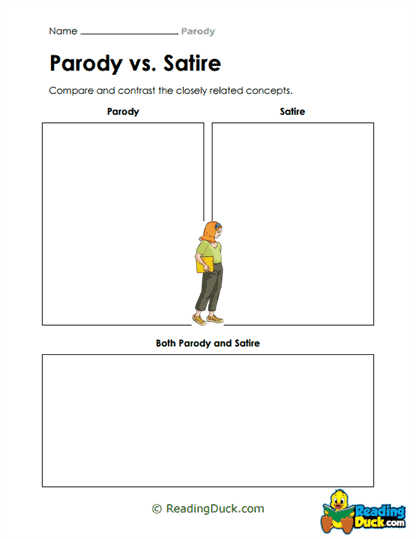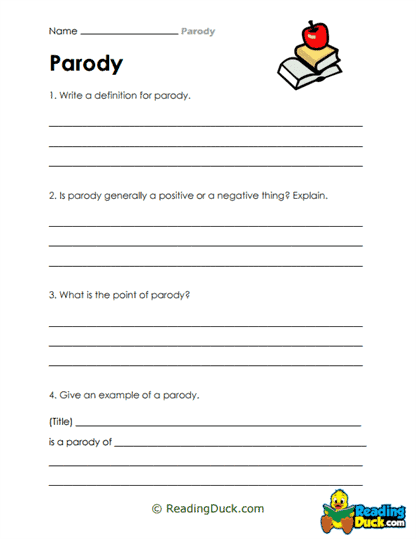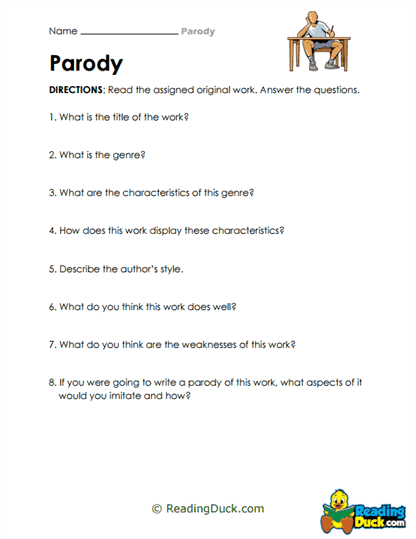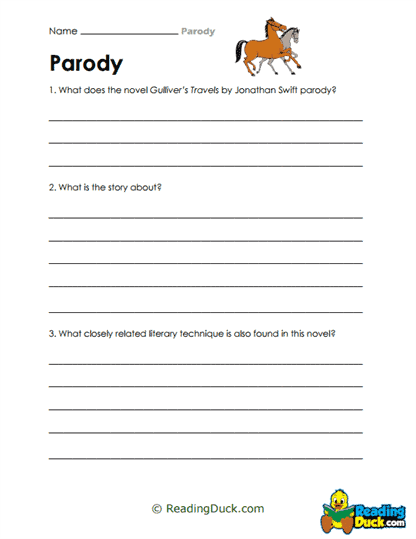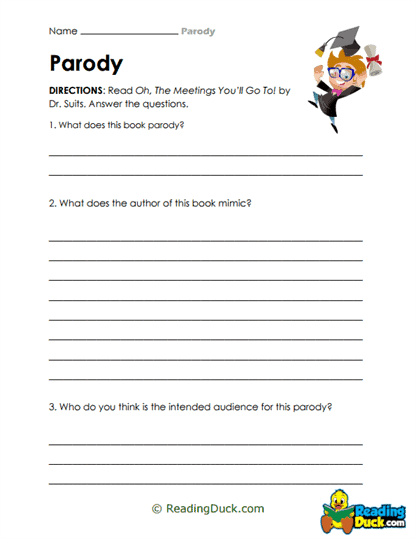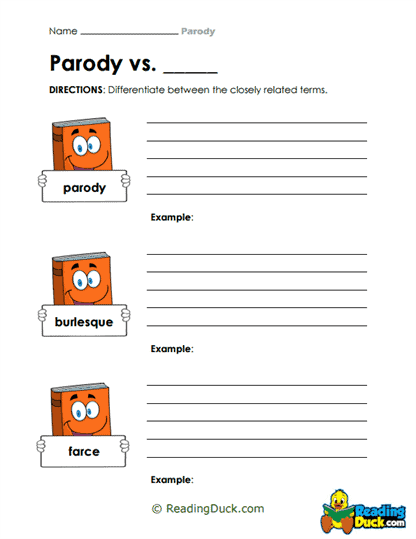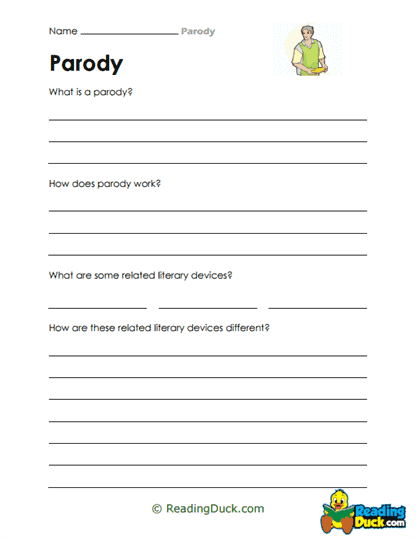Parody Worksheets
About Our Parody Worksheets
Our Parody Worksheets collection, found in the Literary Devices category under the Skills section, is designed to guide students in understanding and mastering the concept of parody as a powerful literary device. These worksheets enable students to explore how parody can be used to imitate, critique, or humorously exaggerate the style or themes of an original work.
By engaging with this collection, students will develop a keen ability to identify and analyze parodies in literature and other media, as well as create their own parodies with a clear sense of purpose and technique. The worksheets are provided in PDF format, making them easy to view, download, and print. Furthermore, each worksheet includes a downloadable answer key, ensuring that students and educators can easily assess progress and understanding.
Defining Parody: A Comprehensive Introduction
A parody is a form of satirical imitation that exaggerates the characteristics of an original work for comedic effect or to critique it. Often lighthearted, parody relies on the reader’s or viewer’s familiarity with the source material in order to generate humor through mimicry and exaggeration.
What is a Parody?
- Imitation with Intent: Parody involves imitating a particular style, genre, or work, but it does so with the intent of creating humor or commentary. The imitation can be subtle or overt, depending on the level of exaggeration.
- Exaggeration for Effect: The key to a successful parody lies in exaggeration. Specific traits of the original work, such as its tone, characters, or plot devices, are amplified in a way that reveals the absurdity or excesses of the original.
- Purposeful Commentary: While parody often entertains, it can also serve as a form of social or cultural commentary. Through humor, parody can highlight flaws or criticize aspects of the original work or the society it represents.
Examples of Parody in Literature
- “Don Quixote” by Miguel de Cervantes: One of the earliest and most famous examples of parody, Don Quixote parodies the chivalric romances popular in the 16th century. The novel follows the delusional Don Quixote as he attempts to live out the adventures of a knight, with his misguided actions serving as a comedic critique of the romantic idealism of the time.
- “Gulliver’s Travels” by Jonathan Swift: Although often seen as a satirical work, Gulliver’s Travels also functions as a parody of travel literature. Swift exaggerates the format and conventions of travel narratives to critique British politics and society.
- “Pride and Prejudice and Zombies” by Seth Grahame-Smith: This modern parody takes Jane Austen’s classic Pride and Prejudice and adds a humorous twist by introducing a zombie apocalypse. The parody retains much of the original’s language and structure but exaggerates the absurdity of societal norms by blending them with supernatural elements.
Types of Parody
- Literary Parody: This involves the imitation of another literary work or genre. It often pokes fun at a particular author’s style or a genre’s conventions.
- Media Parody: Parody extends beyond literature into films, TV shows, and music. For example, Saturday Night Live often parodies current events, political figures, and popular culture.
- Cultural Parody: Some parodies comment on broader cultural or societal norms. They mimic behaviors, institutions, or ideologies to highlight inconsistencies or exaggerations within them.
Parody as a Literary Device: Origins and Characteristics
Parody has a long history as a tool for humor and critique. Understanding its characteristics helps students appreciate its role in literature and its lasting impact on both entertainment and cultural commentary.
Key Characteristics of Parody
- Mimicry with a Twist: At the heart of parody is imitation. However, unlike homage, which is a respectful nod to the original, parody distorts and amplifies the original’s traits for comedic or critical purposes.
- Subversion of Expectations: Parody often plays with the audience’s expectations. By presenting a familiar format or story and then twisting it in unexpected ways, parody creates humor through surprise.
- Satirical Commentary: Parody is often intertwined with satire, using humor to critique or comment on societal norms, cultural trends, or political issues. The exaggeration in parody helps to expose the absurdity of the original work or its context.
Historical Origins of Parody
Parody has existed for centuries and can be traced back to ancient Greece, where it was used in both literature and performance art.
- Classical Greece: The word “parody” comes from the Greek term “parodia,” meaning “counter-song.” Early examples include comedic plays that mimicked the structure and style of tragic dramas, offering a humorous counterpoint to serious works.
- Medieval and Renaissance Parody: During the Renaissance, writers like Miguel de Cervantes used parody to critique societal ideals, particularly in works like Don Quixote, which mocked the romanticization of knighthood.
- Modern Parody: In more recent centuries, parody has evolved into a versatile tool across various media, from literature to films to music, often serving as both entertainment and cultural critique.
Enhancing Literacy Skills through Parody
The study of parody can significantly improve early literacy skills by engaging young learners in creative and analytical exercises. Parody encourages students to think critically about how texts are constructed and how meaning can be manipulated through humor and imitation.
Literacy Benefits of Studying Parody
- Reading Comprehension: When students study parody, they must recognize the original work’s elements being mimicked or exaggerated. This deepens their understanding of both the original and the parody, improving their overall comprehension skills.
- Analytical Thinking: Parody teaches students to look beyond surface-level humor and understand the commentary or critique embedded in the imitation. This develops their analytical thinking and ability to interpret complex texts.
- Creative Writing Skills: By crafting their own parodies, students learn to manipulate language, structure, and tone in creative ways. This encourages experimentation with style and voice, key skills for any writer.
- Enhanced Vocabulary: Reading and writing parody exposes students to a wide range of vocabulary, particularly when they parody works from different genres or time periods.
Engaging Activities for Exploring Parody
To ensure students fully grasp the concept of parody and apply it in meaningful ways, educators can implement various activities that make learning fun, interactive, and effective. These activities can be adapted for different grade levels and are suitable for both traditional classroom settings and homeschool environments.
Creative and Interactive Parody Activities
- Parody a Fairy Tale (Grades 5-8): Ask students to rewrite a classic fairy tale in a modern setting, exaggerating certain traits of the characters or events to create humor. For example, they could reimagine Cinderella as a tech-savvy teenager.
- Parody Poem Challenge (Grades 7-10): Have students create a parody of a famous poem by maintaining its structure and rhyme scheme but altering the subject matter or tone. This activity sharpens their understanding of poetic devices while allowing them to experiment with humor.
- Parody Performance (Grades 6-9): Divide students into groups and ask them to perform a parody of a famous scene from a movie or book. Each group can exaggerate the characters’ personalities or alter the dialogue to humorous effect.
- Create a Parody Poster (Grades 5-7): Encourage students to design a parody of a famous book or movie poster. They can use exaggerated visuals and taglines to highlight the humor in their imitation.
- Parody Debate (Grades 8-12): Organize a debate in which students take on exaggerated personas from well-known literary characters. Their arguments should parody the character’s views or behavior, adding humor and creativity to the discussion.
The Importance of Parody in a Student’s Growth
In conclusion, the study of parody is an essential part of developing critical literacy skills. By engaging with parody, students not only learn to appreciate the nuances of humor and imitation but also deepen their understanding of the works being parodied. Parody encourages creative expression, sharpens analytical thinking, and fosters a more sophisticated comprehension of literary devices.
Academically, students who study parody become more adept at recognizing and interpreting complex layers of meaning in texts. They learn to identify the subtle ways in which authors can critique society, culture, or other works, which broadens their perspective and enhances their critical thinking skills.
On a personal level, crafting and understanding parody allows students to express themselves creatively while engaging with important cultural and societal topics. The humor inherent in parody makes it a powerful tool for fostering a love of literature and writing, while also developing the ability to think critically about the world around them.
This collection of Parody Worksheets provides students with an exciting and interactive way to explore this dynamic literary device. By mastering parody, students will not only improve their reading and writing skills but also enhance their ability to think independently and approach texts with a critical and creative mindset.

